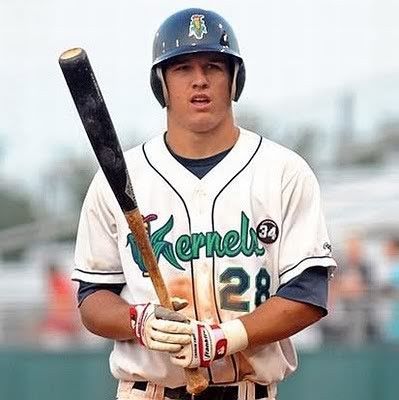
Cedar Rapids (Low-A): AVG-OBP-SLG .362-.454-.526 with 6 HRs and 45 SBs in 312 ABs
Rancho Cucamonga (High-A): AVG-OBP-SLG .306-.388-.434 with 4 HRs and 11 SBs in 196 ABs
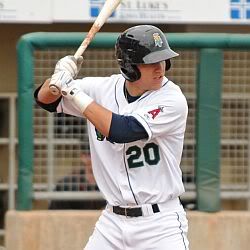
Bats: Right Throws: Right Height: 5’11” 155 lbs. DOB: 3/17/90
Cedar Rapids (Low-A): AVG-OBP-SLG .313-.365-.464 with 10 HRs and 50 SBs in 515 ABs
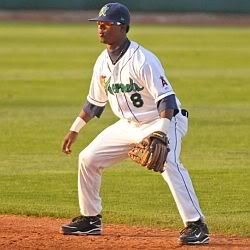
Salt Lake (Triple-A): AVG-OBP-SLG .300-.385-.463 with 11 HRs and 0 SBs in 387 ABs
LAA (Majors): AVG-OBP-SLG .172-.294-.276 with 0 HRs and 0 SBs in 29 ABs
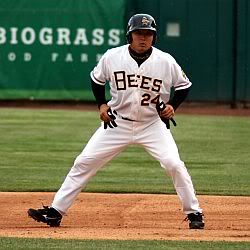
4. Tyler Chatwood (RHP)
Rancho (High-A): 8-3, 0 saves, 1.77 ERA, 70 strikeouts, 36 walks, 81.1 IP
Arkansas (Double-A): 4-6, 0 saves, 3.82 ERA, 36 strikeouts, 27 walks, 68.1 IP
Salt Lake (Triple-A): 1-0, 0 saves, 6.35 ERA, 3 strikeouts, 0 walks, 5.2 IP

5. Jordan Walden (RHP)
Arkansas (Double-A): 1-1, 8 saves, 3.35 ERA, 38 strikeouts, 22 walks, 43.0 IP
Salt Lake (Triple-A): 0-0, 0 saves, 4.05 ERA, 3 strikeouts, 2 walks, 6.2 IP
LAA (Majors): 0-1, 1 save, 2.35 ERA, 23 strikeouts, 7 walks, 15.2 IP
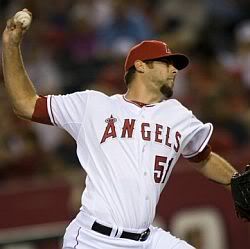
6. Garrett Richards (RHP)
Cedar Rapids (Low-A): 8-4, 0 saves, 3.41 ERA, 108 strikeouts, 34 walks, 108.1 IP
Rancho (High-A): 4-1, 0 saves, 3.89 ERA, 41 strikeouts, 9 walks, 34.2 IP
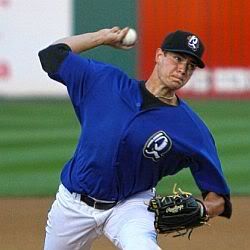
7. Mark Trumbo (1B/RF)
Salt Lake (Triple-A): AVG-OBP-SLG .301-.368-.577 with 36 HRs and 3 SBs in 532 ABs
LAA (Majors): AVG-OBP-SLG .067-.125-.067 with 0 HRs and 0 SBs in 15 ABs
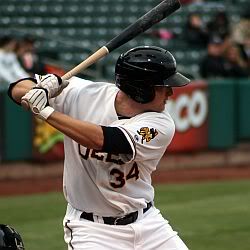
8. Kaleb Cowart (3B)
AZL Angels (Rookie): AVG-OBP-SLG .143-.136-.143 with 0 HRs and 0 SBs in 21 ABs
Orem (Rookie): AVG-OBP-SLG .400-.500-1.000 with 1 HR and 0 SBs in 5 ABs
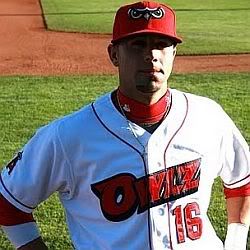
Rancho Cucamonga (High-A): AVG-OBP-SLG .303-.349-.448 with 4 HRs and 17 SBs in 297 ABs
Arkansas (Double-A): AVG-OBP-SLG .288-.332-.325 with 1 HR and 4 SBs in 191 ABs
Salt Lake (Triple-A): AVG-OBP-SLG .400-.412-.585 with 0 HRs and 4 SBs in 65 ABs
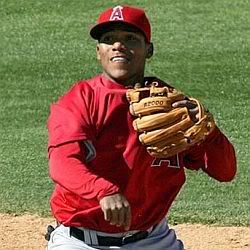
10. Fabio Martinez-Mesa (RHP)
Cedar Rapids (Low-A): 7-3, 0 saves, 3.92 ERA, 141 strikeouts, 76 walks, 103.1 IP
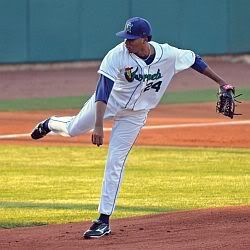
Salt Lake (Triple-A): 4-7, 0 saves, 8.53 ERA, 46 strikeouts, 50 walks, 69.2 IP
Arkansas (Double-A): 3-6, 0 saves, 4.56 ERA, 62 strikeouts, 35 walks, 79.0 IP

AZL Angels (Rookie): AVG-OBP-SLG .327-.365-.714 with 4 HRs and 0 SBs in 49 ABs
Cedar Rapids (Low-A): AVG-OBP-SLG .292-.327-.530 with 7 HRs and 4 SBs in 202 ABs
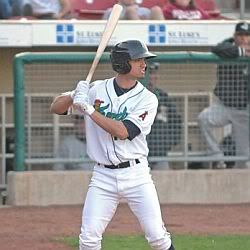
Bats: Left Throws: Right Height: 6’1” 190 lbs. DOB: 6/29/87
Arkansas (Double-A): AVG-OBP-SLG .303-.358-.463 with 13 HRs and 24 SBs in 456 ABs
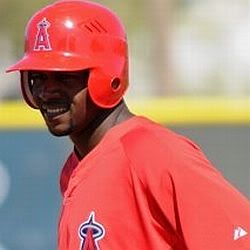
14. Luis Jimenez (3B)
Cedar Rapids (Low-A): AVG-OBP-SLG .292-.332-.476 with 2 HRs and 6 SBs in 168 ABs
Rancho Cucamonga (High-A): AVG-OBP-SLG .286-.324-.522 with 12 HRs and 15 SBs in 318 ABs
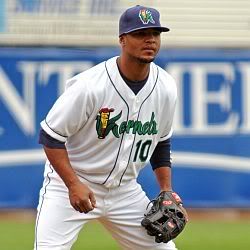
Rancho (High-A): 3-1, 2 saves, 3.44 ERA, 51 strikeouts, 10 walks, 34.0 IP
Arkansas (Double-A): 1-0, 0 saves, 2.41 ERA, 36 strikeouts, 16 walks, 18.2 IP

Orem (Rookie): 2-2, 10 saves, 1.95 ERA, 50 strikeouts, 10 walks, 32.1 IP
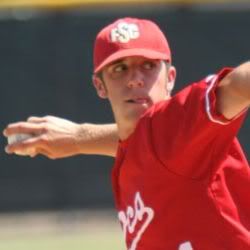
AZL Angels (Rookie): AVG-OBP-SLG .231-.333-.308 with 0 HRs and 0 SBs in 13 ABs
Rancho Cucamonga (High-A): AVG-OBP-SLG .270-.323-.466 with 13 HRs and 3 SBs in 322 ABs
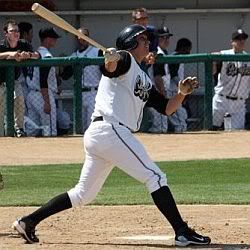
18. Jeremy Berg (RHP)
Cedar Rapids (Low-A): 0-0, 4 saves, 1.17 ERA, 20 strikeouts, 4 walks, 23.0 IP
Rancho (High-A): 1-0, 0 saves, 1.45 ERA, 27 strikeouts, 2 walks, 18.2 IP
Arkansas (Double-A): 1-0, 1 save, 1.50 ERA, 26 strikeouts, 5 walks, 24.0 IP
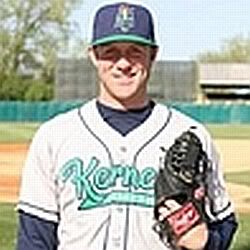
Look for Berg to start the season in Triple-A, and to possibly make an appearance or two in Anaheim by the end of the season.
AZL Angels (Rookie): 0-2, 0 saves, 4.50 ERA, 10 strikeouts, 7 walks, 12.0 IP

Unfortunately, Bedrosian was hurt for most of 2010 and only notched 12.0 IP before the Angels shut him down rather than risking any injury. Bedrosian throws a plus fastball that can hit the mid-90s and a developing breaking ball and changeup. Look for the Angels to be somewhat cautious with him at the start of 2011 as they build up the arm strength for an entire summer of pitching.
Orem (Rookie): AVG-OBP-SLG .309-.365-.472 with 10 HRs and 20 SBs in 288 ABs
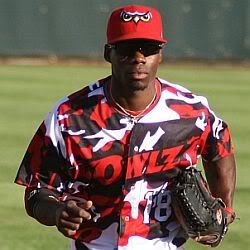
Scouting Report: Under former Scouting Director Eddie Bane, the Angels loved drafting “toolsy” players and that’s exactly what Travis Witherspoon is. Drafted in the 12th round of the 2009 draft, Witherspoon showed what a “toolsy” player can accomplish when he refines his game through hard work and experience.
Offensively, Witherspoon has the potential to be a legitimate 20/20 threat. He has plus speed and power, notching 11 doubles and 3 triples to go along with his 10 HRs. In 2010, Witherspoon stole 20 bases without getting caught once. In his professional career he has only been caught one time in 31 chances. Defensively, Witherspoon can play all three outfield positions. He has the arm and range to play centerfield. He takes good routes and covers a lot of ground.
Witherspoon should start 2011 in Cedar Rapids, where, along with Randal Grichuk and Andrew Heid, he will form a strong young OF nucleus for the Angels. That nucleus should take the Midwest League by storm. With Trout, Bourjos, Moore ahead of this wave on the depth chart, the Angels can afford to move this group through the system a little more slowly.
Cedar Rapids (Low-A): 6-5, 4 saves, 4.56 ERA, 108 strikeouts, 70 walks, 116.1 IP

22. Eddie McKiernan (RHP)
Rancho (High-A): 3-2, 28 saves, 3.40 ERA, 57 strikeouts, 20 walks, 55.2 IP
Salt Lake (Triple-A): 0-0, 0 saves, 20.25 ERA, 2 strikeouts, 1 walks, 1.1 IP
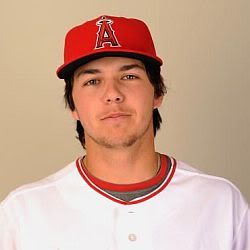
Cedar Rapids (Low-A): 4-5, 0 saves, 2.01 ERA, 36 strikeouts, 15 walks, 53.2 IP
Rancho (High-A): 7-3, 0 saves, 4.55 ERA, 71 strikeouts, 45 walks, 97.0 IP
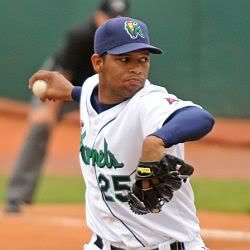
24. Tyson Auer (CF)
Rancho Cucamonga (High-A): AVG-OBP-SLG .332-.387-.453 with 3 HRs and 40 SBs in 196 ABs
Arkansas (Double-A): AVG-OBP-SLG .308-.360-.395 with 2 HRs and 13 SBs in 185 ABs
Salt Lake (Triple-A): AVG-OBP-SLG .255-.327-.426 with 0 HRs and 1 SB in 47 ABs
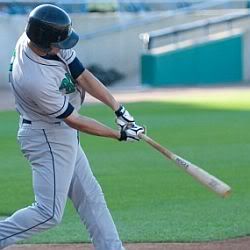
Arkansas (Double-A): AVG-OBP-SLG .282-.370-.366 with 3 HRs and 21 SBs in 383 ABs
LAA (Majors): AVG-OBP-SLG .091-.091-.182 with 0 HRs and 0 SBs in 11 ABs
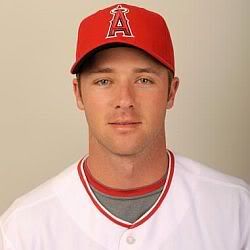
Rancho (High-A): 2-1, 1 save, 3.41 ERA, 82 strikeouts, 20 walks, 68.2 IP

Rancho Cucamonga (High-A): AVG-OBP-SLG .296-.333-.492 with 22 HRs and 6 SBs in 541 ABs
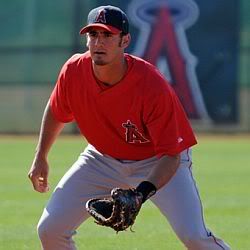
AZL Angels (Rookie): AVG-OBP-SLG .216-.294-.389 with 3 HRs and 9 SBs in 162 ABs
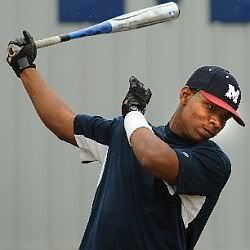
Cedar Rapids (Low-A): AVG-OBP-SLG .226-.337-.381 with 9 HRs and 3 SBs in 257 ABs
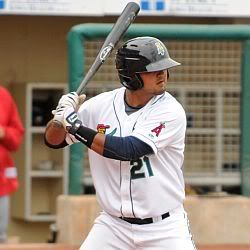
AZL Angels (Rookie): AVG-OBP-SLG .187-.278-.260 with 0 HRs and 11 SBs in 150 ABs
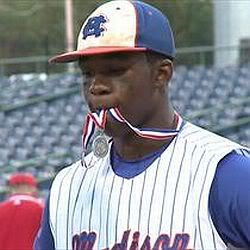
Rancho (High-A): 7-6, 0 saves, 6.36 ERA, 83 strikeouts, 46 walks, 104.2 IP
32. John Hellweg (RHP)
Cedar Rapids (Low-A): 2-4, 16 saves, 4.33 ERA, 66 strikeouts, 45 walks, 43.2 IP
AZL Angels (Rookie): AVG-OBP-SLG .284-.325-.407 with 0 HRs and 8 SBs in 194 ABs
34. Max Russell (LHP)
Orem (Rookie): 4-0, 0 saves, 3.41 ERA, 31 strikeouts, 3 walks, 31.2 IP
Cedar Rapids (Low-A): 2-3, 0 saves, 5.31 ERA, 30 strikeouts, 8 walks, 42.1 IP
35. Andrew Heid (OF)
Orem (Rookie): AVG-OBP-SLG .362-.435-.505 with 9 HRs and 9 SBs in 287 ABs
Bats: Right Throws: Right Height: 6’4” 200 lbs. DOB: 9/28/88
AZL Angels (Rookie): 4-4, 0 saves, 2.68 ERA, 70 strikeouts, 17 walks, 74.0 IP
Cedar Rapids (Low-A): 0-0, 0 saves, 2.79 ERA, 11 strikeouts, 8 walks, 9.2 IP
37. Wendell Soto (SS)
AZL Angels (Rookie): AVG-OBP-SLG .260-.319-.307 with 0 HRs and 13 SBs in 127 ABs
Cedar Rapids (Low-A): AVG-OBP-SLG .287-.353-.449 with 8 HRs and 2 SBs in 296 ABs
Fort Myers (High-A): 0-1, 0 saves, 4.50 ERA, 6 strikeouts, 0 walks, 4.0 IP
New Britain (Double-A): 1-2, 0 saves, 6.37 ERA, 21 strikeouts, 22 walks, 29.2 IP
Arkansas (Double-A): 0-0, 0 saves, 0.0 ERA, 0 strikeouts, 1 walk, 1.0 IP
Cedar Rapids (Low-A): 7-5, 0 saves, 3.76 ERA, 88 strikeouts, 60 walks, 103.0 IP
Rancho (High-A): 0-1, 0 saves, 8.71 ERA, 8 strikeouts, 13 walks, 10.1 IP
Orem (Rookie): 4-1, 1 save, 6.04 ERA, 59 strikeouts, 16 walks, 53.2 IP
Cedar Rapids (Low-A): 1-1, 0 saves, 13.50 ERA, 4 strikeouts, 3 walks, 2.2 IP
AZL Angels (Rookie): 1-2, 0 saves, 4.60 ERA, 27 strikeouts, 12 walks, 31.1 IP
Rancho (High-A): 4-1, 1 save, 2.06 ERA, 39 strikeouts, 14 walks, 35.0 IP
Arkansas (Double-A): 1-3, 0 saves, 4.70 ERA, 21 strikeouts, 18 walks, 38.1 IP
44. Baudilio Lopez (RHP)
AZL Angels (Rookie): 1-1, 1 save, 6.00 ERA, 16 strikeouts, 3 walks, 15.0 IP
Rancho (High-A): 1-0, 0 saves, 2.25 ERA, 14 strikeouts, 10 walks, 20.0 IP
45. Heath Nichols (RHP)
AZL Angels (Rookie): 2-3, 1 saves, 4.20 ERA, 44 strikeouts, 10 walks, 45.0 IP
Orem (Rookie): 4-2, 0 saves, 3.57 ERA, 26 strikeouts, 13 walks, 35.1 IP
Cedar Rapids (Low-A): 2-0, 2 saves, 5.47 ERA, 23 strikeouts, 14 walks, 26.1 IP
Cedar Rapids (Low-A): AVG-OBP-SLG .341-.429-.653 with 13 HRs and 0 SBs in 173 ABs
AZL Angels (Rookie): 0-0, 0 saves, 3.38 ERA, 6 strikeouts, 0 walks, 2.2 IP
Orem (Rookie): 0-1, 0 saves, 3.45 ERA, 14 strikeouts, 2 walks, 15.2 IP
Cedar Rapids (Low-A): 1-2, 0 saves, 3.38 ERA, 20 strikeouts, 9 walks, 26.2 IP
49. David Carpenter (RHP)
Cedar Rapids (Low-A): 2-4, 8 saves, 2.58 ERA, 52 strikeouts, 19 walks, 45.1 IP
50. Young-Il, Jung (RHP)
Cedar Rapids (Low-A): 2-1 0 saves, 1.77 ERA, 23 strikeouts, 22 walks, 22.2 IP
Add The Sports Daily to your Google News Feed!